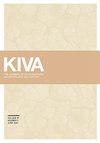The White Ware Pottery from Tijeras Pueblo (LA 581): Learning Frameworks and Communities of Practice and Identity
IF 0.4
0 ARCHAEOLOGY
Kiva-Journal of Southwestern Anthropology and History
Pub Date : 2022-03-31
DOI:10.1080/00231940.2021.2009992
引用次数: 1
Abstract
The Tijeras Pueblo Ceramics Project was designed to explore how the origin and spread of glaze-painted pottery and technology among the Ancestral Eastern Pueblos of the middle Rio Grande was associated with inter-regional macro-scale social processes, such as immigration, population aggregation, and coalescent community formation during the Pueblo IV period in the American Southwest (AD 1275-1425). However, carbon-painted black-on-white ceramics make up over half of the decorated pottery from Tijeras Pueblo and these white wares have their own unique story to tell. In particular, this article argues that the diversity of traits that characterize local carbon-painted black-on-white pottery was directly associated with the context in which novice potters learned to make pots, how technological practices were transmitted and regulated within these communities of practice, and how such practices were related to strategies of coalescence and identity formation around the turn of the fourteenth century.Tijeras Pueblo的白陶(LA 581):实践和身份的学习框架和社区
Tijeras普韦布洛陶瓷项目的目的是探索美国西南部普韦布洛四世时期(公元1275-1425年)的移民、人口聚集和联合社区形成等区域间宏观社会进程与中部地区东部普韦布洛人祖先之间釉彩陶器和技术的起源和传播之间的关系。然而,碳漆黑白陶瓷占Tijeras Pueblo装饰陶器的一半以上,这些白色陶器有自己独特的故事要讲。特别是,这篇文章认为,当地碳漆黑白陶器特征的多样性与新手陶工学习制罐的背景直接相关,技术实践如何在这些实践社区中传播和规范,以及这些实践如何与14世纪之交的合并和身份形成策略相关。
本文章由计算机程序翻译,如有差异,请以英文原文为准。
求助全文
约1分钟内获得全文
求助全文
来源期刊
CiteScore
0.70
自引率
33.30%
发文量
31

 求助内容:
求助内容: 应助结果提醒方式:
应助结果提醒方式:


